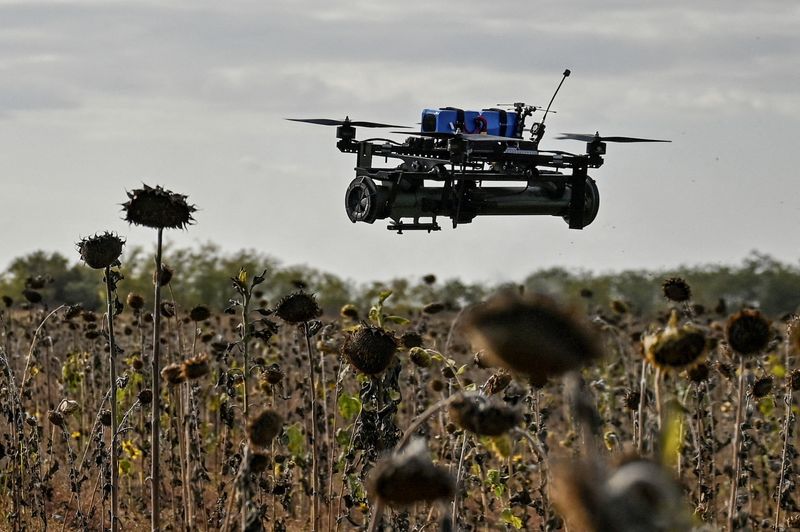By Max Hunder
KYIV (Reuters) - Ukraine is using dozens of domestically made AI-augmented systems for its drones to reach targets on the battlefield without being piloted, a senior official said, disclosing new details about the race against Russia to harness automation.
Systems that use artificial intelligence allow cheap drones carrying explosives to spot or fly to their targets in areas protected by extensive signal jamming, which has reduced the effectiveness of manually piloted drones.
The shift towards the use of AI, particularly in drone target finding and flight control, is an important emerging front in the technology race that has unfolded since Russia launched its full-scale invasion in February 2022.
"There are currently several dozen solutions on the market from Ukrainian manufacturers ... they are being purchased and delivered into the armed forces and other defence forces," Ukraine's deputy defence minister Kateryna Chernohorenko said of drone AI systems.
She said they were currently being used in a targeted way in special operations.
Automated drone systems are in high demand among soldiers searching for ways to beat the rapidly increasing use of electronic warfare on the battlefield.
Electronic warfare systems create a protective dome around their location by sending out powerful signals that disrupt communication between drones and their pilots, causing them to lose control of the craft and miss their target.
These systems, once only used to protect the highest-value pieces of equipment, have become a common feature in trenches and on regular vehicles used by soldiers as they seek to protect themselves from the threat of first person view (FPV) drones.
These small and cheap drones, originally built for civilian enthusiasts to race, have since become the most commonly used strike drone on the battlefield, with both countries ramping up their production into the millions per year.
'NEXT PHASE OF THE WAR'
A Ukrainian official told Reuters in July that most first person view units' target strike rate had fallen to 30%-50%, while for new pilots that can be as low as 10%, and that signal jamming was the main problem.
The official predicted that AI-operated first person view drones could achieve hit rates of around 80%.
Samuel Bendett, adjunct senior fellow at the Center for a New American Security, a Washington-based think-tank, said statements from officials on both sides showed automation would likely play an important role in the next phase of the war, but that it was currently not widespread.
"At this point in the conflict, we're seeing small scale application of these technologies as multiple developers are trying to position themselves and their drones as the go to solution," he said.
"Right now, the solutions are relatively simple and often based on commercial technologies that have been available even before the war, but more complicated features can also become available."
Ukraine is also using interceptor drones to down the vast numbers of Russian camera reconnaissance drones helping target artillery and missile strikes on Ukrainian targets behind the lines.
Chernohorenko, the defence official, said that these also needed to be equipped with AI targeting.
"Russian reconnaissance drones are causing huge problems on the frontlines (but) they are now being shot down rather effectively by our interceptors."
COMPUTER VISION
Dmytro Vovchuk, the chief operating officer of NORDA Dynamics, a Ukrainian company which makes software for drones, told Reuters they had been making a product which used computer vision, a type of AI technology, to guide strike drones towards their target.
The software allows a pilot to select a target via the drone's camera, at which point the craft completes the rest of the flight into it autonomously.
The company has sold over 15,000 units of its automated targeting software to drone manufacturers, with over 10,000 of those already delivered.
Although in raw terms that is a large number, it is still a tiny proportion of the 4 million drones Ukraine says it is now capable of producing annually.
Vovchuk said strikes could not always be visually confirmed due to the heavy presence of electronic warfare systems around high-value targets.
"From what we have seen, three tanks were definitely destroyed with our systems, as well as a lot (of strikes) on logistics targets," he said, adding that it had also been used to hit field headquarters.

"Those things which are defended by electronic warfare ... this system has enabled strikes on targets which previously it was not cost-effective to hit."
(This story has been refiled to remove repeated word from quote in paragraph 14)